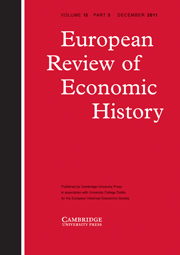Crossref Citations
This article has been cited by the following publications. This list is generated based on data provided by
Crossref.
Rönnbäck, Klas
2010.
An Early Modern Consumer Revolution in the Baltic?.
Scandinavian Journal of History,
Vol. 35,
Issue. 2,
p.
177.
FAITH, ROSAMOND
SCHOFIELD, P. R.
HEALEY, JONATHAN
MURPHY, ANNE L.
BRADLEY, KATE
TAYLOR, JAMES
and
BROWNLOW, GRAHAM
2011.
Review of periodical literature published in 2009.
The Economic History Review,
Vol. 64,
Issue. 1,
p.
256.
Chilosi, David
and
Volckart, Oliver
2011.
Money, States, and Empire: Financial Integration and Institutional Change in Central Europe, 1400–1520.
The Journal of Economic History,
Vol. 71,
Issue. 3,
p.
762.
Jacks, D. S.
2011.
Foreign wars, domestic markets: England, 1793-1815.
European Review of Economic History,
Vol. 15,
Issue. 2,
p.
277.
Federico, G.
2011.
When did European markets integrate?.
European Review of Economic History,
Vol. 15,
Issue. 1,
p.
93.
ETRO, FEDERICO
and
PAGANI, LAURA
2012.
The Market for Paintings in Italy During the Seventeenth Century.
The Journal of Economic History,
Vol. 72,
Issue. 2,
p.
423.
Ronnback, K.
2012.
The speed of ships and shipping productivity in the age of sail.
European Review of Economic History,
Vol. 16,
Issue. 4,
p.
469.
Hynes, William
Jacks, David S.
and
O'rourke, Kevin H.
2012.
Commodity market disintegration in the interwar period.
European Review of Economic History,
Vol. 16,
Issue. 2,
p.
119.
FEDERICO, GIOVANNI
2012.
How much do we know about market integration in Europe?1.
The Economic History Review,
Vol. 65,
Issue. 2,
p.
470.
DOBADO-GONZÁLEZ, RAFAEL
GARCÍA-HIERNAUX, ALFREDO
and
GUERRERO, DAVID E.
2012.
The Integration of Grain Markets in the Eighteenth Century: Early Rise of Globalization in the West.
The Journal of Economic History,
Vol. 72,
Issue. 3,
p.
671.
Rönnbäck, Klas
2013.
The Encyclopedia of Global Human Migration.
Sharp, Paul
and
Weisdorf, Jacob
2013.
Globalization revisited: Market integration and the wheat trade between North America and Britain from the eighteenth century.
Explorations in Economic History,
Vol. 50,
Issue. 1,
p.
88.
Lampe, Markus
and
Sharp, Paul
2014.
Handbook of Cliometrics.
p.
1.
Ekberg, Espen
and
Lange, Even
2014.
Business history and economic globalisation.
Business History,
Vol. 56,
Issue. 1,
p.
101.
Chilosi, David
and
Federico, Giovanni
2015.
Early globalizations: The integration of Asia in the world economy, 1800–1938.
Explorations in Economic History,
Vol. 57,
Issue. ,
p.
1.
Rönnbäck, Klas
2016.
Transaction costs of early modern multinational enterprise: measuring the transatlantic information lag of the British Royal African Company and its successor, 1680–1818.
Business History,
Vol. 58,
Issue. 8,
p.
1147.
de Zwart, Pim
2016.
Globalization in the Early Modern Era: New Evidence from the Dutch-Asiatic Trade, c. 1600–1800.
The Journal of Economic History,
Vol. 76,
Issue. 2,
p.
520.
Lampe, Markus
and
Sharp, Paul
2016.
Handbook of Cliometrics.
p.
295.
de Zwart, Pim
and
van Zanden, Jan Luiten
2018.
The Origins of Globalization.
Federico, Giovanni
2018.
Handbook of Cliometrics.
p.
1.


